Canine Hip Dysplasia
If you're looking to buy a purebred dog, particularly a large breed, one of the most important questions you can ask a prospective breeder is, "what screening have you done for hip dysplasia?" Learn more about this crippling, painful disease below.
Anatomy of Canine Hip Dysplasia
When a puppy is formed in the womb, the hip joint is supposed to form as a ball at the top of the femur (known as the caput) and a shallow bowl-like socket or indentation at the side of the pelvic bone (known as the acetabulum). Covering both the ball and the socket is a layer of cartilage that creates a smooth surface to cushion and protect the joint during movement. Tendons and ligaments surround the joint, holding the two sides together and keeping the ball from dislocating out of the socket.
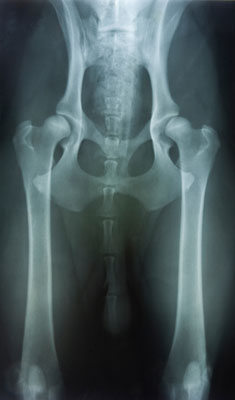
In somewhere between 15 and 20% of dogs, the hip joint forms abnormally. It is thought that several gene defects contribute to the problem, and environmental problems such as obesity, overexertion, repetitive motion, and injuries probably worsen the situation. Injuries and over-exertion at a very young age are especially problematic, which is why most dog sports do not allow participants younger than six months of age.
Although hip dysplasia can occur in any dog, it is most common in large purebreds including Great Danes, Saint Bernards, Labrador and Golden Retrievers, and German Shepherds. There is no gender prevalence - both sexes are afflicted equally.
There are two common forms of the disease. In the first, the ball portion of the joint isn't seated tightly in the socket, resulting in the hip joint feeling very loose. The second form of hip dysplasia results when the surface of the ball and / or the socket isn't smooth. The instability of the joint or the uneven surface then causes friction upon movement, resulting in joint inflammation.
As the dog walks, the joint becomes inflamed which breaks down the cartilage covering the ball and socket. Inflammation causes more degradation, and it becomes a vicious cycle of inflammation, degradation, inflammation, degradation... Eventually, all of the cartilage is worn away, causing the ball to grind against the socket, bone-on-bone. Known as osteoarthritis, this bone-on-bone movement without any shock-absorbing cartilage in between is quite painful.
Symptoms of Canine Hip Dysplasia
The early symptoms of hip dysplasia are rather mild and are generally due to the looseness of the joint. You might notice your dog has a swaying gait and has a hard time standing up. As the disease progresses, the osteoarthritic degeneration causes pain, leading to more advanced symptoms. You will see your dog's activity level decline including an unwillingness to run or jump. Range of motion in the joint will decrease, as will muscle mass in the thighs.
The symptoms of the disease are made worse by the fact that decreased activity often leads to weight gain, which is about the worst thing for a dog with arthritic hips. Poor nutrition is another contributing factor, with giant breed dogs being especially susceptible if food made especially for giant breeds is not used. These dogs grow so fast, it is important to nutritionally support their joints during puppyhood.
The changes related to dysplasia often don't show on an X-ray until the puppy reaches the age of two years, although your dog might show symptoms of pain well before then.
Treatment of Canine Hip Dysplasia
There is no cure for hip dysplasia, but there are several things you can do to help your dog feel better. Physical therapy such as swimming provides passive joint motion which can decrease stiffness while maintaining muscle mass. Carefully monitoring your dog's diet to control his or her weight is the most important home treatment. You might also ask your veterinarian about anti-inflammatory drugs and a pain management regimen. Glucosamine can help the dog maintain the remaining cartilage and even build new cushioning material in the joint.
Mobility aids such as ramps, steps, weight-bearing harnesses, strollers, and wheelchairs are also available to help your dog get around.
When the disease is severe, there are several surgical options that can provide pain relief. For very young dogs (those less than 10 months old) with no evidence of arthritic degeneration, triple pelvic osteotomy, known as TPO, is the surgery of choice. The veterinary surgeon makes three incisions in your dog and cuts the pelvic bone into three sections. The hip sockets are then rotated into a position that allows the ball at the top of the femur to sit more solidly in the socket. Pins are used to maintain the correct alignment. It takes the dog about 3 months to recover, and the surgery has a 90% success rate.
Less commonly, a veterinary surgeon might perform excision arthroplasty to reshape the head of the femur, allowing it to sit more securely in the hip socket.
Finally, for adult dogs who are experiencing severe osteoarthritis, your vet may suggest a total hip replacement, in which both the ball and the socket are replaced with synthetic material. In some cases, the ball portion of the hip may be removed, leaving just the muscles to act as a joint. This is uncommon, but is sometimes done in smaller dogs.
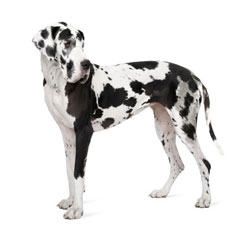
Prevention of Canine Hip Dysplasia
The best way to prevent hip dysplasia is to remove it from the breeding pool. This means that any dog who has hip dysplasia should not be bred, nor should his or her parents. The parents may never show clinical signs of dysplasia, but because the genetics that produce the disease are so complex, it is important that they not be re-bred, even with different partners, after producing even one puppy with dysplasia. What makes this even more complicated is that a puppy may not show symptoms for at least a year or two, and the parents may have been re-bred several times before the breeder even knows of the problem.
When you're interviewing breeders for your new puppy, be sure to ask to see certification that both of the parents have been cleared by a program designed to reduce the incidence of canine hip dysplasia. The most common certifications come from the Orthopedic Foundation for Animals (OFA), the PennHIP program at the University of Pennsylvania, or the British Veterinary Association (BVA).
Doggies Den: Latest Articles
 Homemade Thanksgiving Treats for Your Dog
Homemade Thanksgiving Treats for Your Dog
NUTRITION We all want to include our dogs in our holiday celebrations, but hopefully, you're aware that sharing table scraps with your dog isn't always the best idea.
 Keeping Your Dog Safe during the Summer Months
Keeping Your Dog Safe during the Summer Months
HEALTH Summer is coming on fast, so it’s time to plan how you will keep your dog safe and healthy through the lazy, carefree, warm days.
 Vaccination Time Again-Keeping Your Puppy Healthy
Vaccination Time Again-Keeping Your Puppy Healthy
DOG HEALTH So you have your new puppy picked out. There are quite a few shots, treatments and examinations that will keep the newest member of your family healthy.
 Canine Thanksgiving Feast
Canine Thanksgiving Feast
NUTRITION With the wide variety of food at Thanksgiving dinner, chances are you'll want to give your dog something special, too. If you're contemplating what to feed your dog for the holiday, here is a guide to a great Canine Thanksgiving Feast.
 Dog Walking Tips Every Owner Should Know
Dog Walking Tips Every Owner Should Know
DOG FUN Walking your dog is not only crucial to keeping him healthy and happy, it strengthens the bond between your canine friend and his caregiver. There are a lot of obstacles out there. Don’t forget these simple tips to keep your walk fun and safe in the outside world.
 The Benefits of Physiotherapy for your Dog
The Benefits of Physiotherapy for your Dog
HEALTH The same techniques that physiotherapists use to treat a variety of injuries and conditions in humans have been adapted to suit animals with great success. Family pets, show dogs, and working dogs can all benefit greatly from physiotherapy. Dogs whose activities involve a lot of agility are especially susceptible to the types of problems that physiotherapy can address.
 The Decision- Adding a Dog to Your Family
The Decision- Adding a Dog to Your Family
FIRST TIME OWNERSBringing a dog into your family is a decision where many people don’t realize it’s magnitude until after they have the dog. There are a number of things that you need to research before you decide to purchase a dog, and it starts right in your own home.
 Bringing Your Dog Into Your New Baby's Life
Bringing Your Dog Into Your New Baby's Life
HEALTH Many believe that a dog and a new baby cannot happily coexist, so therefore the dog has to go. This is not necessarily the case. A new baby does not mean you have to abandon your dog.

Doggies Den:
Most Popular Articles

Dog Pregnancy Symptoms
HEALTHIf you suspect your dog might be pregnant, check out part one in this series on pregnant dogs, where we cover pregnant dog symptoms.
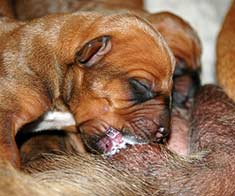
Dog Birth
HEALTHIn the third article of our dog pregnancy series, we look at the wonderful, but messy, process of bringing newborn puppies into the world.

Indoor Dog Potties
DOG PRODUCTSIt's been a long day at work. You were so busy, you didn't even take time to eat a sandwich, let alone run home to let your dog out. You're on your way home, knowing the poor dog is crossing his or her legs by now, when your car breaks down, delaying you even further. Can't somebody make this easier?
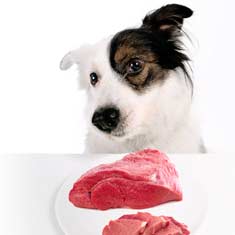
Your Dog’s Digestive System
PHYSIOLOGYEver wonder why your dog eats so fast? Or why he eats gross things? Or why he gets sick to his stomach? Or why his waste stinks so bad? Some of these things are normal, some are not.

Canine Respiratory System
BREATHINGThe basic function of your dog's respiratory system is to bring oxygen in to and remove carbon dioxide from the body. Knowing the symptoms of respiratory diseases can help you help your stay healthy.
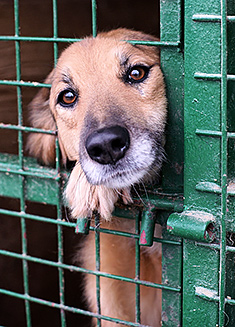
Shelter Dog Adoption Tips for Success
ADOPTION Are you intimidated by the prospect of "rescuing" a dog from a shelter? One reason that you may be wary of adopting a dog from a shelter is not knowing how to choose. Adopting a dog from a shelter can be a rewarding process, if you're prepared to do a reasonable amount of research.

Canine Urinary Tract Infections
SYMPTOMS AND TREATMENTDoes your dog seem to be having trouble relieving his or her bladder? Learn how to recognize the signs of urinary tract infections and how to treat them before they spread.

What to do for Dog Diarrhea
SYMPTOMS AND REMEDIESIf you have dogs in your house for any length of time, you have likely experienced at least one bout of dog diarrhea. Beyond the pain in the tuckus involved in cleaning up the mess, you should know what causes diarrhea, and when it's important to see the vet.
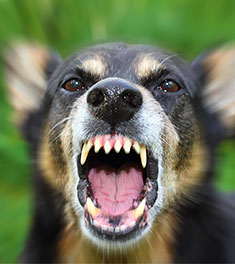
What to do for a Dog Bite
DOG BEHAVIOR Getting bitten by a dog can be scary, and you may be tempted to run around in circles for a while, trying to figure out what to do. Here's our guide to help you manage the situation.

Top Ten Tips for Living with a Senior Dog
DOG HEALTH Bringing home a new puppy is so exciting, but it doesn’t take all that long for your exuberant puppy to grow into a senior dog who may have special needs. Here are the doggies.com top ten tips for taking care of your companion who has been with you through so much.
